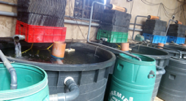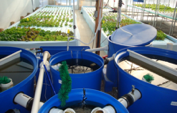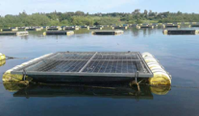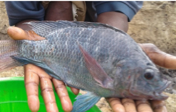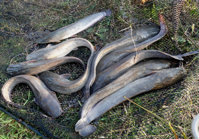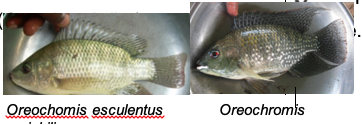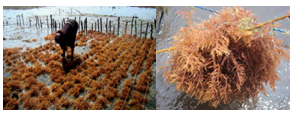Aquaculture
Introduction
- Aquaculture is the farming of aquatic organisms (fish, crustaceans and plants) in freshwater, seawater or brackish water.
- Kenya has a great potential for commercial aquaculture to fill the gap in national fish supply due to the declining wild caught fish from rivers and lakes.
- Aquaculture provides food security, employment opportunities and reduce poverty among households. Aquaculture is done in:
- Semi intensive systems- pond fertilization is done alongside feeder e.g. Ponds
- Intensive systems - fish are stocked and high densities with complete feeding e.g. Recirculating aquaculture (RAS), cages and aerated ponds.
| Culture systems | |
|
Pond based production systems
|
|
|
Recirculating aquaculture systems (RAS)
|
|
| Culture systems | |
|
Aquaponics systems
|
|
|
Integrated culture systems
|
|
|
Low volume, high-density (LVHD) cages
|
|
| Breeds | |
|
Improved Nile tilapia [F7-2017-01] ]
|
|
|
Improved Marine Tilapia
(Photo by Dr. Mirera) |
|
|
Improved Catfish Strain [F3-2017-01]
|
|
| Breeds | |
|
Indigenous Fish Species ( Victoria tilapia (Oreochromis variabilis), Singida tilapia,(Oreochromis esculentus), Jipe tilapia, (Oreochromis jipe)
|
|
|
Barbus altianalis and Ningu, Labeo victorianus
(Photo by Jacob abwao) |
|
|
Coastal aquaculture species |
|
|
Milkfish (Chanos chanos)
|
|
|
Red snapper (Lutjanus argentinamaculus)/ (Tembu)
Photo from http://bigfish.co.ke/red-snapper.html |
|
|
Mud crab (Scylla serrata) (Kaa)
|
|
|
Prawn (Penaeus monodon) (Kamba)
|
|
|
Sea weed (Kappaphycus alvarezii)
(Photos from KMFRI state of aquaculture report) |
|
For all aquaculture species the site for aquaculture should have the following attributes: -
- Have adequate quality water which supports the requirements of the species cultured.
- Have a gentle slope (5-10%) for land based aquaculture.
- Large enough to allow for construction and future expansion.
- Free from sources of contamination.
- Free from heavy metals and pesticide residues.
- Away from sewage pollution and upstream of any form of discharge.
- Suitable to support the life of the species being cultured.
- Safe from destruction and theft.
- Away from thick vegetation that harbor predators.
- Feed formulation is done for all fish species depending on their nutritional requirements. Fish require different feeds at different stages of life (fry, fingerling, grow out and broodstock).
- Nutritional considerations are made for protein, amino acids lipid, fatty acids, vitamins, minerals, and energy requirements for normal growth and healthy fish.
- Grow out fish performs better when fed feeds with crude protein level between 26 to 40%
- Fish feed ingredients are selected based on availability, low cost, and simplicity of handling during processing.
- Common ingredients are:-
- Roots and tubers (Cassava, sweet potato leaves).
- Cereals and cereal by-products (maize meal, maize germ, maize bran, wheat pollard, wheat bran, rice bran, brewers waste).
-
- Oil-seed cakes (cotton, sunflower, soybean, groundnut, canola).
- Feeds of animal origin (Blood meal, Fish meal, Fish offal, hydrolyzed feather meal and Black soldier fly larvae meal).
- Feed formulation is done by Pearson square method or linear programming which uses a computer software.
- The nutrition composition of the formulated feed should be according to the Kenya bureau of standards Feed standards.

- Feeds should always be bought from certified feed suppliers.
- Feed should be utilized within the shortest time after purchase to a maximum period of three months.
- Feed should be stored in raised racks/pallets away from any form of moisture.
- Feed should be stored in a cool, dry and well ventilated place.
- Feed store should be kept clean and free from pests.
- Feed with high moisture, mould, or rancidity should be disposed of according to guidelines.
Feeding equipment
For all fish being cultured feeding is either done by hand or mechanized. The mechanized feeding equipment


